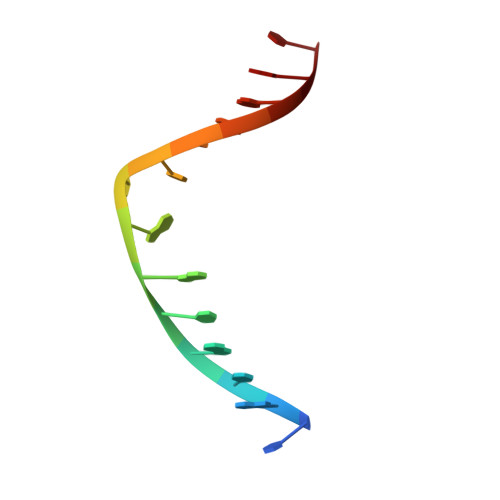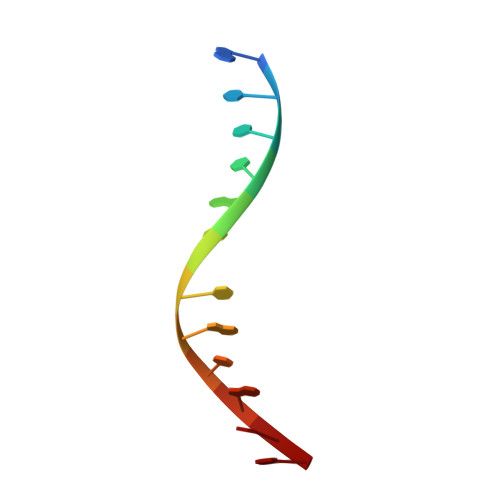Stereochemical control of small molecule binding to bulged DNA: comparison of structures of spirocyclic enantiomer-bulged DNA complexes.
Hwang, G.S., Jones, G.B., Goldberg, I.H.(2004) Biochemistry 43: 641-650
- PubMed: 14730968
- DOI: https://doi.org/10.1021/bi035824i
- Primary Citation of Related Structures:
1R4E - PubMed Abstract:
The solution structure of the complex formed between an oligonucleotide containing a two-base bulge (5'-CACGCAGTTCGGAC.5'-GTCCGATGCGTG) and ent-DDI, a designed synthetic agent, has been elucidated using high-resolution NMR spectroscopy and restrained molecular dynamic simulation. Ent-DDI is a left-handed wedge-shaped spirocyclic molecule whose aglycone portion is an enantiomer of DDI, which mimics the spirocyclic geometry of the natural product, NCSi-gb, formed by base-catalyzed activation of the enediyne antibiotic neocarzinostatin. The benzindanone moiety of ent-DDI intercalates between the A6.T21 and the T9.A20 base pairs, overlapping with portions of the purine bases; the dihydronaphthalenone moiety is positioned in the minor groove along the G7-T8-T9 bulge sequence; and the aminoglycoside is in the middle of the minor groove, approaching A20 of the nonbulged strand. This alignment of ent-DDI along the DNA helical duplex is in the reverse direction to that of DDI. The aminoglycoside moiety of ent-DDI is positioned in the 3' direction from the bulge region, whereas that of the DDI is positioned in the 5' direction from the same site. This reverse binding orientation within the bulge site is the natural consequence of the opposite handedness imposed by the spirocyclic ring junction and permits the aromatic ring systems of the two spirocyclic enantiomers access to the bulge region. NMR and CD data indicate that the DNA in the DDI-bulged DNA complex undergoes a larger conformational change upon complex formation in comparison to the ent-DDI-bulged DNA, explaining the different binding affinities of the two drugs to the bulged DNA. In addition, there are different placements of the bulge bases in the helical duplex in the two complexes. One bulge base (G7) stacks inside the helix, and the other one (T8) is extrahelical in the DDI-bulged DNA complex, whereas both bulge bases in the ent-DDI-bulged DNA complex prefer extrahelical positions for drug binding. Elucidation of the detailed binding characteristics of the synthetic spirocyclic enantiomers provides a rational basis for the design of stereochemically controlled drugs for bulge binding sites.
Organizational Affiliation:
Department of Biological Chemistry and Molecular Pharmacology, Harvard Medical School, Boston, Massachusetts 02115, USA.




















